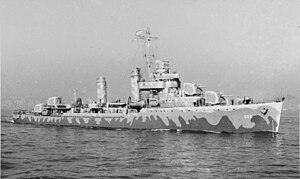 USS Meade on 20 June 1942
| |
| Class overview | |
|---|---|
| Name | Benson class |
| Builders |
|
| Operators | |
| Preceded by | Sims class |
| Succeeded by | Gleaves class |
| Subclasses |
|
| Built | 1938–43 |
| In commission | 1940–51 |
| Completed | 30 |
| Lost | 4 (1 returned to service) |
| Retired | 27 |
| General characteristics | |
| Type | Destroyer |
| Displacement |
|
| Length |
|
| Beam | 36 ft 1 in (11.00 m) |
| Draft |
|
| Installed power |
|
| Propulsion | 2 shafts |
| Speed |
|
| Range | 6,500 nautical miles (12,000 km; 7,500 mi) at 12 kn (22 km/h; 14 mph) |
| Complement | 208 (276 wartime) |
| Sensors and processing systems | |
| Armament |
|
| Notes | |
The Benson class was a class of destroyers of the U.S. Navy built 1939–1943. The thirty 1,620-ton Benson-class destroyers were built in two groups. The first six were authorized in fiscal year 1938 (FY38) and laid down at Bethlehem Steel, Quincy, Massachusetts, and three naval shipyards.[1] The remaining 24 "repeat Bensons" were authorized in 1940–42 and built at four Bethlehem Steel yards. They were laid down after the first group was commissioned. These plus the "repeat Livermores" (also known as "repeat Gleaveses") were also known at the time as the Bristol class. During World War II the Bensons were usually combined with the Livermores (more correctly the Gleaves class) as the Benson-Livermore class; this persisted in references until at least the 1960s. In some references both classes are combined and called the Benson class. The Benson- and Gleaves-class destroyers were the backbone of the pre-war Neutrality Patrols and brought the action to the enemy by participating in every major campaign of the war.
- ^ a b Benson class at DestroyerHistory.org
- ^ "Benson Class at Destroyers.org". Archived from the original on 16 November 2013. Retrieved 9 November 2015.
- ^ Friedman, pp. 95–109, 470–471